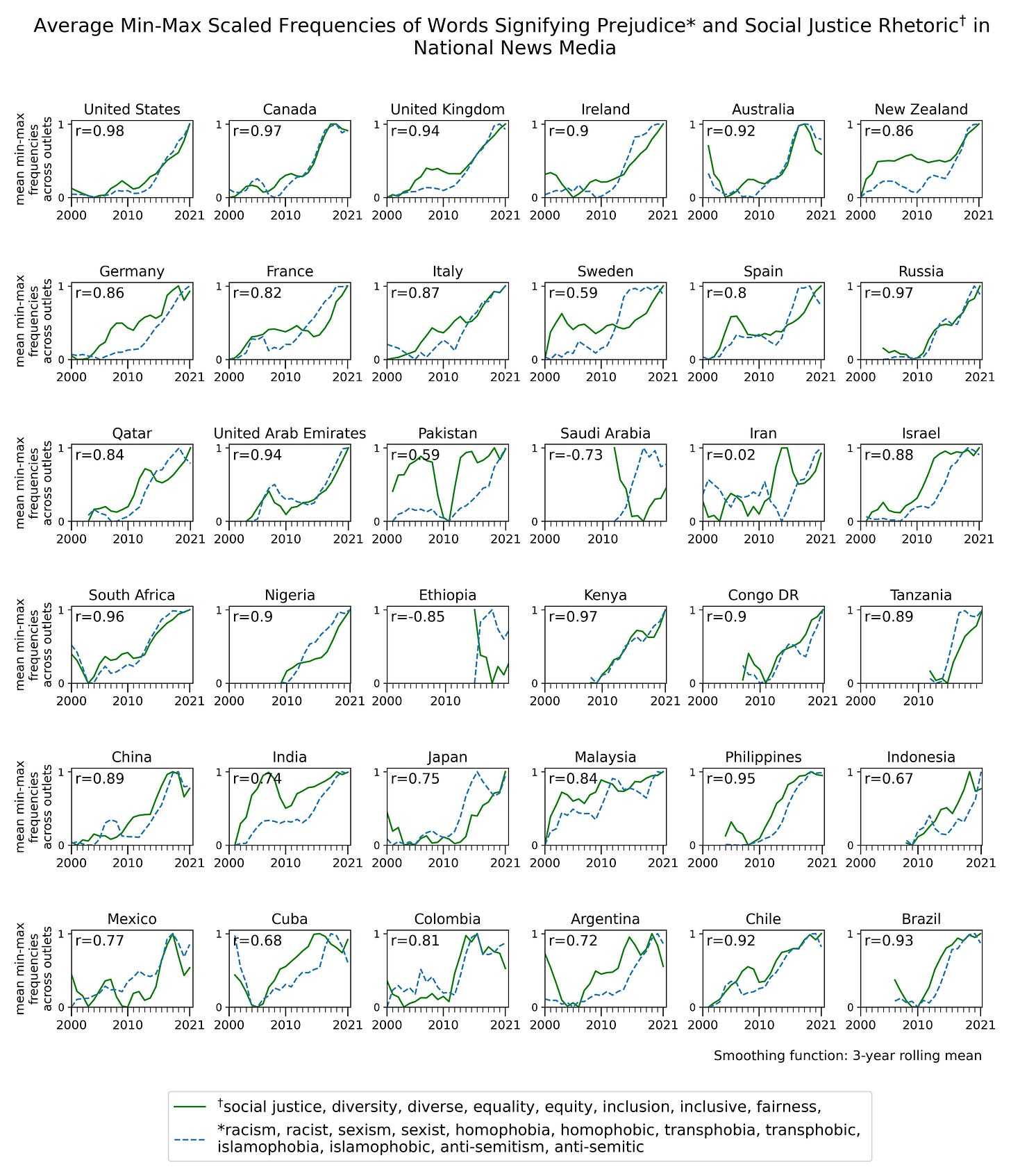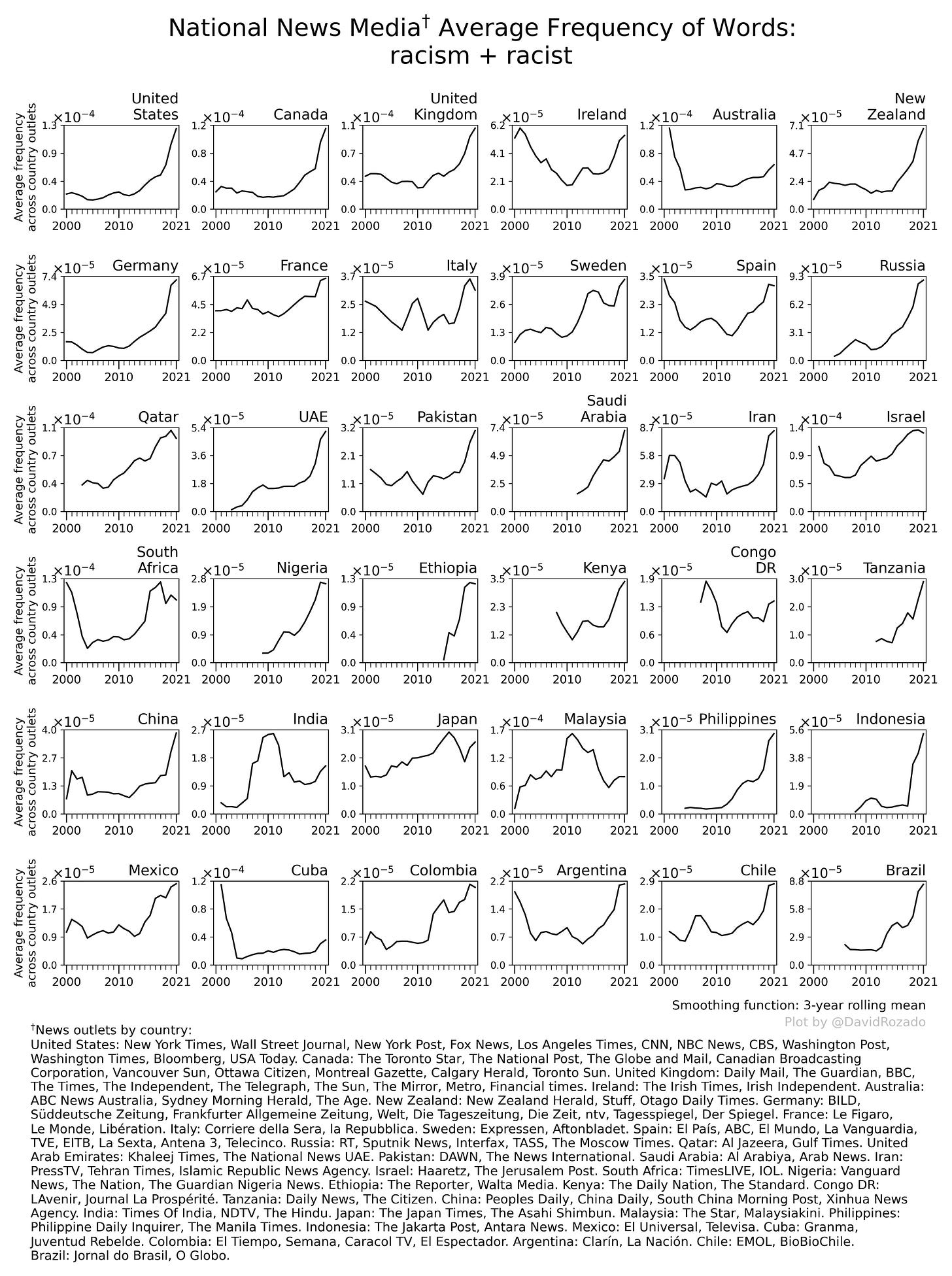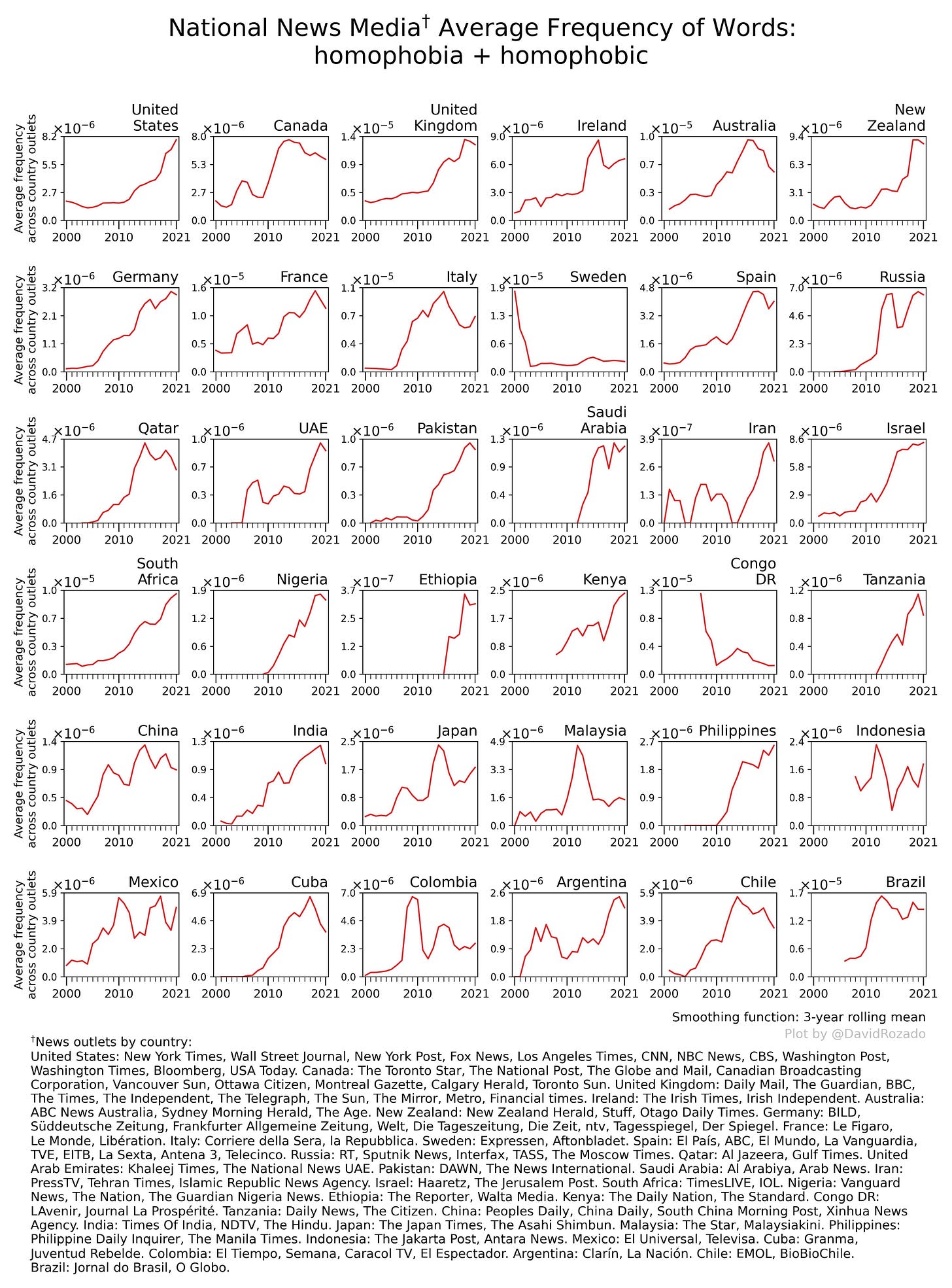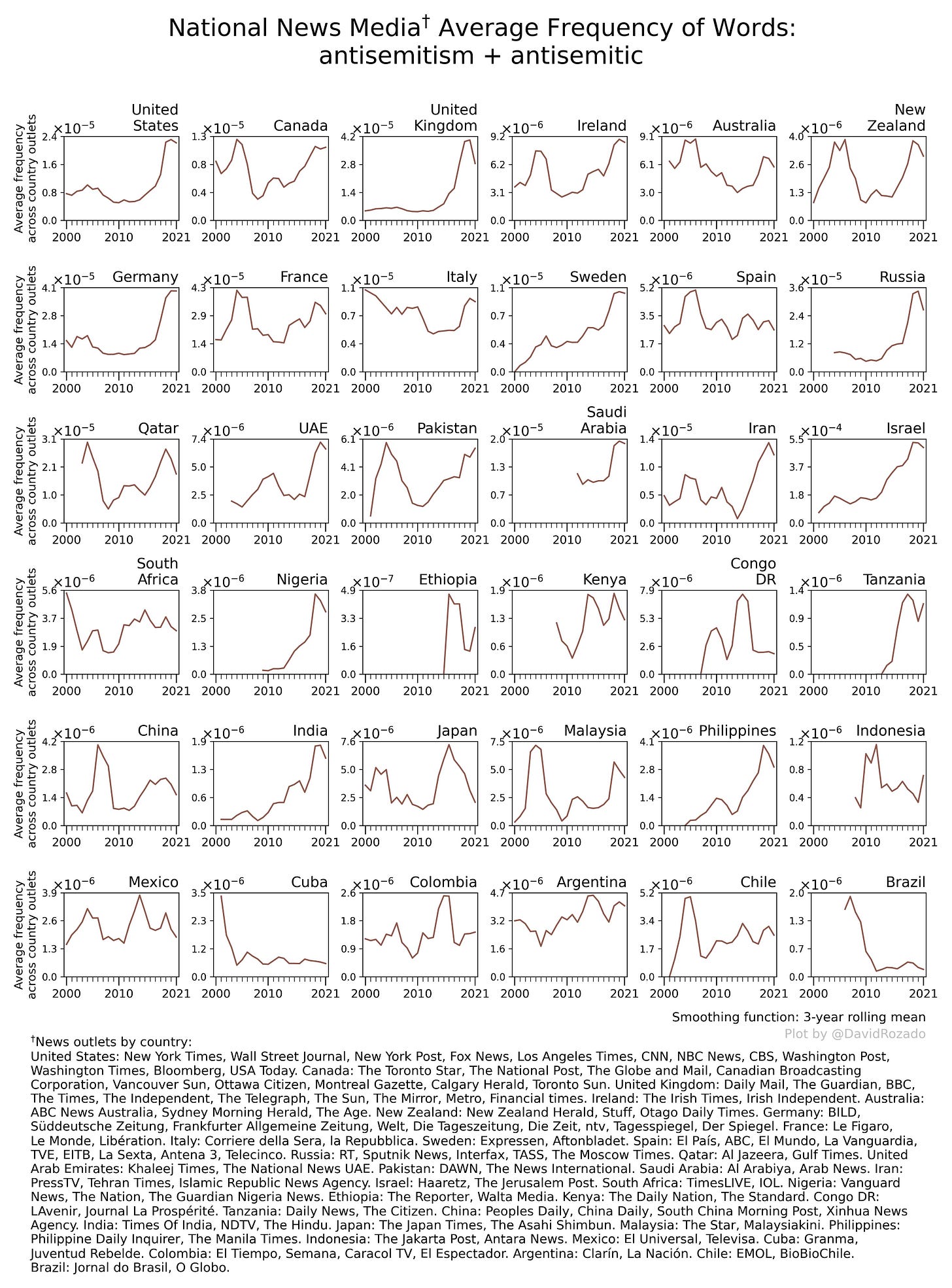Mentions of Prejudice in News Media -- An International Comparison
The striking synchronicity with which Great Awokening terminology increased in news media worldwide
Context
I have documented previously a post-2010 sharp increase of words used to denounce prejudice (i.e. racism, sexism, homophobia, Islamophobia, anti-Semitism, etc) in US and UK news media content. Some have referred to these trends and related shifts in US public opinion about increasing perceptions of prejudice severity in society as the Great Awokening or wokeness.
In a recent Preprint, I extend previous analyses to the global media environment. To do so, I quantify the prevalence of prejudice-denouncing terms and social justice associated terminology (diversity, inclusion, equality, etc) in over 98 million news and opinion articles across 124 popular news media outlets from 36 countries representing 6 different world regions: English-speaking West, continental Europe, Latin America, sub-Saharan Africa, Persian Gulf region and Asia.
An important limitation of this work is the variable news media sample representativeness of different countries. While some countries in our analysis like the United States, Russia, Colombia, Canada, Germany or Spain have a multitude of outlets in the sample, other countries have more limited sample sizes like for instance Japan which is only composed of two news outlets. Yet, previous research hints that news media usage of terms that denote prejudice is highly correlated between outlets within a country. So perhaps this limitation is not too severe in terms of impacting the generalizability of the results. Additionally, while the analysis often used news media content in the local language when possible, occasionally I had to settle for local news media with English content, like China’s People’s Daily or Japan’s The Asahi Shimbun. It is conceivable that there might be differences in content between those outlets content in English and the same outlets content in the country’s local language since they target different audiences. Yet, the English content versions still provide a valuable, if yet imperfect, proxy to gather insight about a country news media content.
Summary of results
Results show that increasing prominence in news media of so-called Great Awokening terminology is a global phenomenon starting early post-2010 in pioneering countries yet mostly worldwide ubiquitous post-2015. Note that the frequency of each prejudice-denoting term in the figure below has been normalized using min-max feature scaling to the range 0-1. This is done to neutralize differences in frequency ranges for different terms and thus obtain an overall estimate of when the aggregate set of terms signifying prejudice is being used, on average, at minimum, medium and maximum prevalence.
The previous figure aggregates all prejudice signifying terms into a single metric, thereby obscuring prejudice-specific dynamics globally as well as prevalence of prejudice-specific themes by country. To study prejudice-specific dynamics worldwide the next Figure shows the average global relative frequency across the different prejudice signifying terms studied. All terms display, on average, a global increase in prominence since at least 2010.
Different world regions and countries emphasize distinct types of prejudice with varying degrees of intensity. News media from Western countries, some gulf region countries and South Africa display the heaviest usages of ethnic prejudice denouncing terminology .
Gender prejudice is most prominent in Western countries as well as Latin America. The topic of gender prejudice is particularly salient in Spanish news media, with a prevalence that almost triples in size the prominence of this topic in any other country.
The topics of sexual orientation and gender identity are most prominent in Western countries and Latin American. The topic of islamophobia is most prominent in Gulf region countries, including Israel.
The United States news media uses references to prejudice above the worldwide average, but it is not always the heaviest user of prejudice-denouncing terminology among its Western peers.

To assess the temporal dynamics of how the increasing prevalence of prejudice-signifying terminology has come about in different world regions, the next figure shows the average min-max scaled frequencies of our sample prejudice-denoting terms in the six different world regions studied. The trend appears mostly moderately in sync across all of them. Plotting some of the countries that appear to peak first in their usage of prejudice signifying terminology plus the United States, shows that American news media, on average, was not a pioneer in the increasing deployment of references to terms that signify prejudice and that other countries such as Sweden, Canada or Australia began to increase the deployment of prejudice denouncing terminology earlier than news media from the United States. Similarly, when plotting some international news media outlets and the newspaper of record in the United States, the New York Times, we can also observe that the New York Times was not a pioneer in the increasing usage of prejudice signifying terminology.
Looking at prejudice-specific topics, we obtain additional evidence that the abrupt rise in the usage of prejudice specific terminology did not begin in the the United States.
Replicating the min-max scaled analysis of prejudice signifying terminology with an additional set of terms often associated with social justice discourse and positive connotations such as diversity, inclusion or fairness, see green trend in Figure below, shows that terms often associated with social justice discourse also display a marked increase in prevalence post-2010. Furthermore, their dynamics are highly correlated with the previously studied prejudice-denouncing terms in most of the studied countries (see the large Pearson correlation coefficient, r, between both time series).
The previous analysis presents a picture of global news media increasing usage of prejudice denouncing terminology and social justice discourse. However, are all countries using these lexicons for the same purpose or with the same intention? A preliminary qualitative analysis of Russia’s, Iran’s and China’s state media such as RT, Sputnik News, Tehran Times, Islamic Republic News Agency, People’s Daily or China Daily suggests that this is not the case. While in Western news media, most mentions of prejudice occur in a context of denouncing prejudice, mostly within Western nations, mentions of terms signifying prejudice in adversarial countries of the West are almost never used introspectively to denounce prejudice within their frontiers but rather they are used to criticize (or mock, in the case of some Russian state-controlled media) alleged prejudice in the West.
Conclusions
The strong association in news media content between prejudice signifying words and social justice terminology with positive connotations suggests that they are related to the same underlying phenomena. Yet their very different emotional valence (extremely negative in the case of prejudice signifying words and markedly positive in the case of positive social justice rhetoric) suggests the multifaceted nature of the so-called Great Awokening.
Future research should try to elucidate the causal factors responsible for the global massive increase in news media usage of terminology that references prejudice. Despite the potential for a multitude of causes driving the trend, the synchronicity of the phenomena worldwide is noteworthy and deserving of future investigation.
Update (8/4/2023)
There has been some valid comments mentioning that min-max scaling can overstate mild trends. Hence, I plot next relative frequencies for comparisons of baseline rates and slopes across countries and prejudice types.
Ethnic prejudice:
Gender prejudice:
Sexual orientation prejudice:
Gender identity prejudice:
Islamophobia:
Antisemitism (probably the most heterogeneous trends of all prejudice types)














Nice work, David. I think you'll find much starker effects looking at "systemic racism" than just racism. That construct or abstraction is substantively essential to the new leftist ideology that swept our institutions and media in the last few years. Basically, the ideology of the academic left replaced mainstream leftist, née "liberal", ideology. Also, "structural racism/oppression", though I think systemic is more common. This is core to CRT, critical theory generally, Marxism, etc.
Another suggestion to get at bias is to look for whether terms are quoted or not. For example, you'll find newspaper articles in the 1990s, maybe later, where systemic racism is wrapped in quotes, which it should be since it's a proprietary leftist construct that is fully contested in terms of existing or describing reality re: black or brown people in the US in 2023 (I think conservatives, libertarians, and some leftists would find use for the term to describe discrimination against Asians in college admissions, possibly white kids as well).
Media that use ideological constructs as *descriptive* are profoundly biased and unprofessional. It's the difference between referring to systemic racism just taking for granted that it's real, much less the cause of some outcome (as asserted in leftist ideology), as opposed to quoting it and saying that these people claim "systemic racism" is the cause of XYZ.
You'll also find outlets like the NYT wrapping transgender in quotes in 1995, probably later as well. It's a new, synthetic ideological construct, so that's appropriate. So tracking media wrapping leftist ideological constructs in quotes, and then no longer doing that, would be an interesting way to trace their radicalization.
And using fake clinical-sounding pathology terms like transphobic, homophobic, Islamophobic, etc. to label a human being merits special attention and condemnation, especially if it's just for mundane disagreement or non-compliance with leftist ideology (like noting that there are two sexes, or opposing men crashing women's sports). All these outlets that do it should be excoriated, and we need to build online tools and databases that document it, and hold them to account. So use of x-phobic specifically might be worth teasing apart from x-phobia, especially if you can determine that it's been applied as a label for a specific person. These terms aren't actually "prejudice types" as far as anyone knows – they're non-existent, fake clinical-sounding pathology terms created by political ideologues to smear dissenters. So their use in media isn't like racism, and is inherently biased – in my view it should be called out specially.
To me this is part of a broader trend of global *aesthetic* convergence (see here for an exploration https://www.alexmurrell.co.uk/articles/the-age-of-average).
The way journalists write about issues, and which issues they choose to report on, is being influenced by the Western, and especially American, zeitgeist. I suspect this is not due to any objective, global uptick in actual prejudice nor any structural dynamics that might be present in each of the counties mentioned.